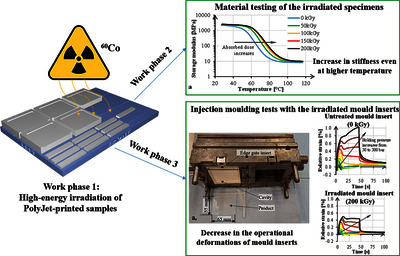Krizsma, Szabolcs and Mészáros, László and Kovács, Norbert Krisztián and Suplicz, András (2025) Expanding the applicability of material jetting–printed photopolymer prototype injection moulds by gamma irradiation post-treatment. JOURNAL OF MANUFACTURING PROCESSES, 134. pp. 135-145. ISSN 1526-6125
|
Text
1-s2.0-S1526612524013173-main.pdf - Published Version Available under License Creative Commons Attribution. Download (5MB) | Preview |
|
![[img]](https://real.mtak.hu/216317/7.hassmallThumbnailVersion/1-s2.0-S1526612524013173-ga1_lrg.jpg)
|
Text (graphical abstract)
1-s2.0-S1526612524013173-ga1_lrg.jpg - Published Version Available under License Creative Commons Attribution. Download (279kB) | Preview |
Abstract
Additive manufacturing (AM) revolutionized modern production and tooling, as it can help speed up the development process. This is also true for injection moulding. For instance, polymeric low-volume injection moulds are easy to produce by material jetting (MJ) technologies like PolyJet™. The downside of these MJ printed moulds is their relatively low glass transition temperature, which can result in unacceptably low stiffness and increased creep compliance in the operational temperature range. Different post-curing techniques like high-energy irradiation can enhance the degree of cross-linking in MJ-printed photopolymer parts. We applied MJ (PolyJet™ technology) to produce specimens for mechanical and morphological characterizations and low-volume injection moulds. After printing, we subjected the specimens and the inserts to high-energy gamma irradiation with doses of 50 kGy, 100 kGy, 150 kGy and 200 kGy. Dynamic mechanical analysis (DMA) showed the effects of irradiation on material properties: the glass transition temperature of the photopolymer rose by almost 10 °C from 70.8 °C of the untreated insert to 81.6 °C of the specimen irradiated with 200 kGy. The creep time temperature superposition (TTS) tests proved that the increasing irradiation doses significantly reduced creep compliance, which resulted in considerably lower mould insert deformations. Creep compliance measured at 35 °C fell from 1920 μm2/N of the untreated specimen to 518 μm2/N of the specimen irradiated with 200 kGy. After the material tests, we applied an elaborated comprehensive state monitoring system (operational strain, cavity pressure and temperature measurements) to highlight the fundamental effect that the irradiation has on the operational behaviour of the MJ-printed mould inserts. Injection moulding tests showed that the increasing irradiation doses resulted in significantly decreased operational deformations. Maximal operational strain of the mould inserts fell from 1 % measured on the untreated (0 kGy) insert to 0.5 % measured on the insert irradiated with 200 kGy. It is highly desirable because product dimensional accuracy is also increased. Irradiation also significantly increased mould life (the number of products that can be manufactured), which is a crucial advantage from an economic point of view. We proved that post-curing by gamma radiation is a feasible way to enhance the applicability and the dimensional stability of photopolymer injection mould inserts. This is a definitely novel way to enhance the applicability of MJ-printed low-volume injection moulds.
| Item Type: | Article |
|---|---|
| Uncontrolled Keywords: | Rapid tooling, Injection moulding, Material jetting, High-energy gamma irradiation, Dynamic mechanical analysis, Creep test |
| Subjects: | T Technology / alkalmazott, műszaki tudományok > TJ Mechanical engineering and machinery / gépészmérnöki tudományok |
| Depositing User: | Dr. Tamás Tábi |
| Date Deposited: | 05 Mar 2025 06:27 |
| Last Modified: | 05 Mar 2025 06:27 |
| URI: | https://real.mtak.hu/id/eprint/216317 |
Actions (login required)
 |
Edit Item |




